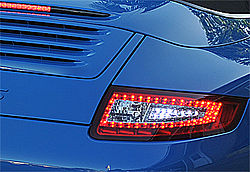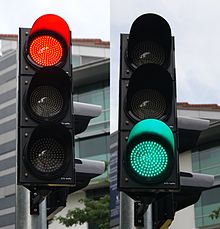In general, all the LED products can be divided into two major parts, the public lighting and indoor lighting. LED uses fall into four major categories:
Visual signals where light goes more or less directly from the source to the human eye, to convey a message or meaning.
Illumination where light is reflected from objects to give visual response of these objects.
Measuring and interacting with processes involving no human vision.
Narrow band light sensors where LEDs operate in a reverse-bias mode and respond to incident light, instead of emitting light.

For more than 70 years, until the LED, practically all lighting was incandescent and fluorescent with the first fluorescent light only being commercially available after the 1939 World's Fair.
Indicators and signs

The low energy consumption, low maintenance and small size of modern LEDs has led to uses as status indicators and displays on a variety of equipment and installations. Large-area LED displays are used as stadium displays and as dynamic decorative displays. Thin, lightweight message displays are used at airports and railway stations, and as destination displays for trains, buses, trams, and ferries.
One-color light is well suited for traffic lights and signals, exit signs, emergency vehicle lighting, ships' navigation lights or lanterns (chromacity and luminance standards being set under the Convention on the International Regulations for Preventing Collisions at Sea 1972, Annex I and the CIE) and LED-based Christmas lights. In cold climates, LED traffic lights may remain snow covered. Red or yellow LEDs are used in indicator and alphanumeric displays in environments where night vision must be retained: aircraft cockpits, submarine and ship bridges, astronomy observatories, and in the field, e.g. night time animal watching and military field use.
Because of their long life and fast switching times, LEDs have been used in brake lights for cars' high-mounted brake lights, trucks, and buses, and in turn signals for some time, but many vehicles now use LEDs for their rear light clusters. The use in brakes improves safety, due to a great reduction in the time needed to light fully, or faster rise time, up to 0.5 second faster than an incandescent bulb. This gives drivers behind more time to react. It is reported that at normal highway speeds, this equals one car length equivalent in increased time to react. In a dual intensity circuit (rear markers and brakes) if the LEDs are not pulsed at a fast enough frequency, they can create a phantom array, where ghost images of the LED will appear if the eyes quickly scan across the array. White LED headlamps are starting to be used. Using LEDs has styling advantages because LEDs can form much thinner lights than incandescent lamps with parabolic reflectors.
Due to the relative cheapness of low output LEDs, they are also used in many temporary uses such as glowsticks, throwies, and the photonic textile Lumalive. Artists have also used LEDs for LED art.
Weather/all-hazards radio receivers with Specific Area Message Encoding (SAME) have three LEDs: red for warnings, orange for watches, and yellow for advisories & statements whenever issued.
Lighting
With the development of high-efficiency and high-power LEDs, it has become possible to use LEDs in lighting and illumination. Replacement light bulbs have been made, as well as dedicated fixtures and LED lamps. To encourage the shift to very high efficiency lighting, the US Department of Energy has created the L Prize competition. The Philips Lighting North America LED bulb won the first competition on August 3, 2011 after successfully completing 18 months of intensive field, lab, and product testing.
LEDs are used as street lights and in other architectural lighting where color changing is used. The mechanical robustness and long lifetime is used in automotive lighting on cars, motorcycles, and bicycle lights.
LED street lights are employed on poles and in parking garages. In 2007, the Italian village Torraca was the first place to convert its entire illumination system to LEDs.
LEDs are used in aviation lighting. Airbus has used LED lighting in their Airbus A320 Enhanced since 2007, and Boeing plans its use in the 787. LEDs are also being used now in airport and heliport lighting. LED airport fixtures currently include medium-intensity runway lights, runway centerline lights, taxiway centerline and edge lights, guidance signs, and obstruction lighting.
LEDs are also suitable for backlighting for LCD televisions and lightweight laptop displays and light source for DLP projectors (See LED TV). RGB LEDs raise the color gamut by as much as 45%. Screens for TV and computer displays can be made thinner using LEDs for backlighting.
LEDs are used increasingly in aquarium lights. In particular for reef aquariums, LED lights provide an efficient light source with less heat output to help maintain optimal aquarium temperatures. LED-based aquarium fixtures also have the advantage of being manually adjustable to emit a specific color-spectrum for ideal coloration of corals, fish, and invertebrates while optimizing photosynthetically active radiation (PAR), which raises growth and sustainability of photosynthetic life such as corals, anemones, clams, and macroalgae. These fixtures can be electronically programmed to simulate various lighting conditions throughout the day, reflecting phases of the sun and moon for a dynamic reef experience. LED fixtures typically cost up to five times as much as similarly rated fluorescent or high-intensity discharge lighting designed for reef aquariums and are not as high output to date.
The lack of IR or heat radiation makes LEDs ideal for stage lights using banks of RGB LEDs that can easily change color and decrease heating from traditional stage lighting, as well as medical lighting where IR-radiation can be harmful. In energy conservation, the lower heat output of LEDs also means air conditioning (cooling) systems have less heat to dispose of, reducing carbon dioxide emissions.
LEDs are small, durable and need little power, so they are used in hand held devices such as flashlights. LED strobe lights or camera flashes operate at a safe, low voltage, instead of the 250+ volts commonly found in xenon flashlamp-based lighting. This is especially useful in cameras on mobile phones, where space is at a premium and bulky voltage-raising circuitry is undesirable.
LEDs are used for infrared illumination in night vision uses including security cameras. A ring of LEDs around a video camera, aimed forward into a retroreflective background, allows chroma keying in video productions.
LEDs are now used commonly in all market areas from commercial to home use: standard lighting, AV, stage, theatrical, architectural, and public installations, and wherever artificial light is used.
LEDs are increasingly finding uses in medical and educational applications, for example as mood enhancement, and new technologies such as AmBX, exploiting LED versatility. NASA has even sponsored research for the use of LEDs to promote health for astronauts.
Smart lighting
Light can be used to transmit broadband data, which is already implemented in IrDA standards using infrared LEDs. Because LEDs can cycle on and off millions of times per second, they can be wireless transmitters and access points for data transport. Lasers can also be modulated in this manner.
Sustainable lighting
Efficient lighting is needed for sustainable architecture. In 2009, a typical 13-watt LED lamp emitted 450 to 650 lumens, which is equivalent to a standard 40-watt incandescent bulb. In 2011, LEDs have become more efficient, so that a 6-watt LED can easily achieve the same results. A standard 40-watt incandescent bulb has an expected lifespan of 1,000 hours, whereas an LED can continue to operate with reduced efficiency for more than 50,000 hours, 50 times longer than the incandescent bulb.
Energy consumption
In the US, one kilowatt-hour of electricity will cause 1.34 pounds (610 g) of CO2 emission. Assuming the average light bulb is on for 10 hours a day, one 40-watt incandescent bulb will cause 196 pounds (89 kg) of CO2 emission per year. The 6-watt LED equivalent will only cause 30 pounds (14 kg) of CO2 over the same time span. A building’s carbon footprint from lighting can be reduced by 85% by exchanging all incandescent bulbs for new LEDs.
Economically sustainable
LED light bulbs could be a cost-effective option for lighting a home or office space because of their very long lifetimes. Consumer use of LEDs as a replacement for conventional lighting system is currently hampered by the high cost and low efficiency of available products. 2009 DOE testing results showed an average efficacy of 35 lm/W, below that of typical CFLs, and as low as 9 lm/W, worse than standard incandescents.
However, as of 2011, there are LED bulbs available as efficient as 150 lm/W and even inexpensive low-end models typically exceed 50 lm/W. The high initial cost of commercial LED bulbs is due to the expensive sapphire substrate, which is key to the production process. The sapphire apparatus must be coupled with a mirror-like collector to reflect light that would otherwise be wasted.
Other applications
The light from LEDs can be modulated very quickly so they are used extensively in optical fiber and free space optics communications. This include remote controls, such as for TVs, VCRs, and LED Computers, where infrared LEDs are often used. Opto-isolators use an LED combined with a photodiode or phototransistor to provide a signal path with electrical isolation between two circuits. This is especially useful in medical equipment where the signals from a low-voltage sensor circuit (usually battery-powered) in contact with a living organism must be electrically isolated from any possible electrical failure in a recording or monitoring device operating at potentially dangerous voltages. An optoisolator also allows information to be transferred between circuits not sharing a common ground potential.
Many sensor systems rely on light as the signal source. LEDs are often ideal as a light source due to the requirements of the sensors. LEDs are used as movement sensors, for example in optical computer mice. The Nintendo Wii's sensor bar uses infrared LEDs. Pulse oximeters use them for measuring oxygen saturation. Some flatbed scanners use arrays of RGB LEDs rather than the typical cold-cathode fluorescent lamp as the light source. Having independent control of three illuminated colors allows the scanner to calibrate itself for more accurate color balance, and there is no need for warm-up. Further, its sensors only need be monochromatic, since at any one time the page being scanned is only lit by one color of light. Touch sensing: Since LEDs can also be used as photodiodes, they can be used for both photo emission and detection. This could be used, for example, in a touch-sensing screen that registers reflected light from a finger or stylus.
Many materials and biological systems are sensitive to or dependent on light. Grow lights use LEDs to increase photosynthesis in plants and bacteria and viruses can be removed from water and other substances using UV LEDs for sterilization. Other uses are as UV curing devices for some ink and coating methods, and in LED printers.
Plant growers are interested in LEDs because they are more energy-efficient, emit less heat (can damage plants close to hot lamps), and can provide the optimum light frequency for plant growth and bloom periods compared to currently used grow lights: HPS (high-pressure sodium), metal-halide (MH) or CFL/low-energy. However, LEDs have not replaced these grow lights due to higher price. As mass production and LED kits develop, the LED products will become cheaper.
LEDs have also been used as a medium-quality voltage reference in electronic circuits. The forward voltage drop (e.g., about 1.7 V for a normal red LED) can be used instead of a Zener diode in low-voltage regulators. Red LEDs have the flattest I/V curve above the knee. Nitride-based LEDs have a fairly steep I/V curve and are useless for this purpose. Although LED forward voltage is far more current-dependent than a good Zener, Zener diodes are not widely available below voltages of about 3 V.





